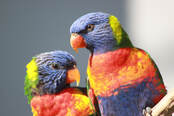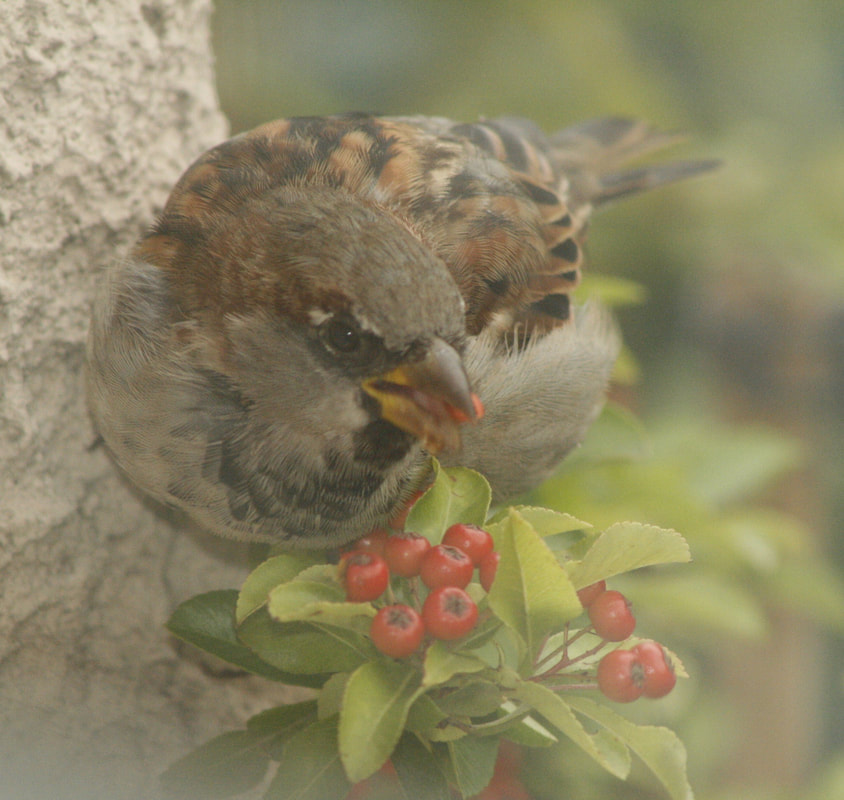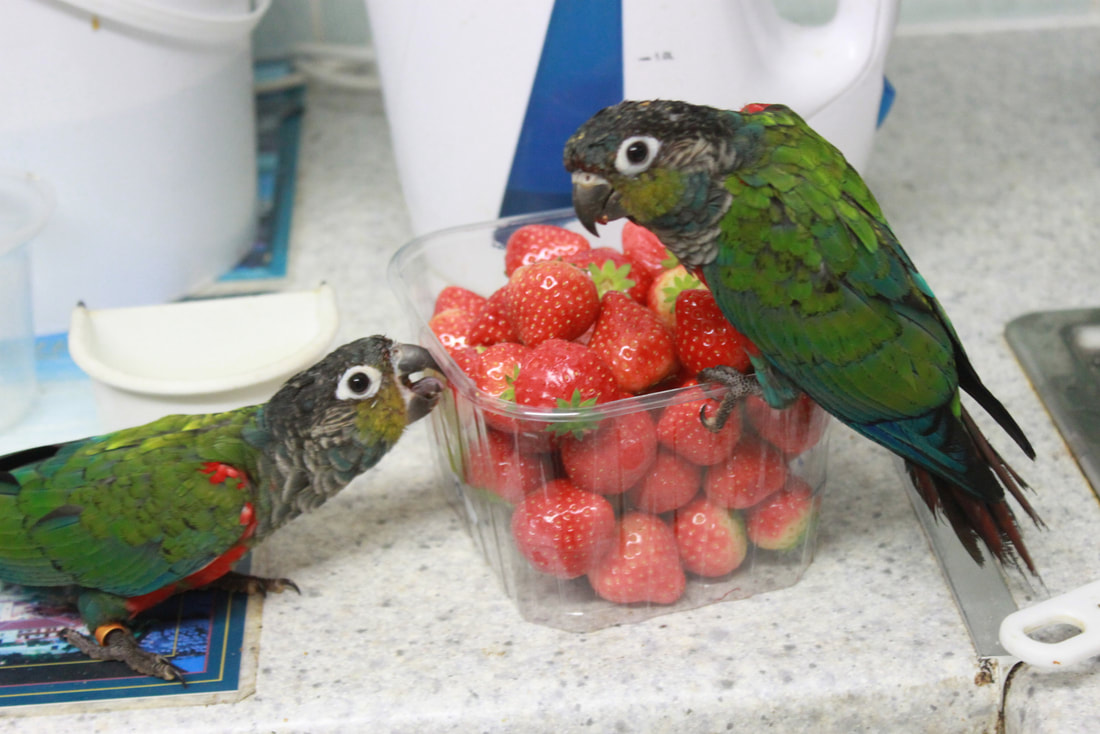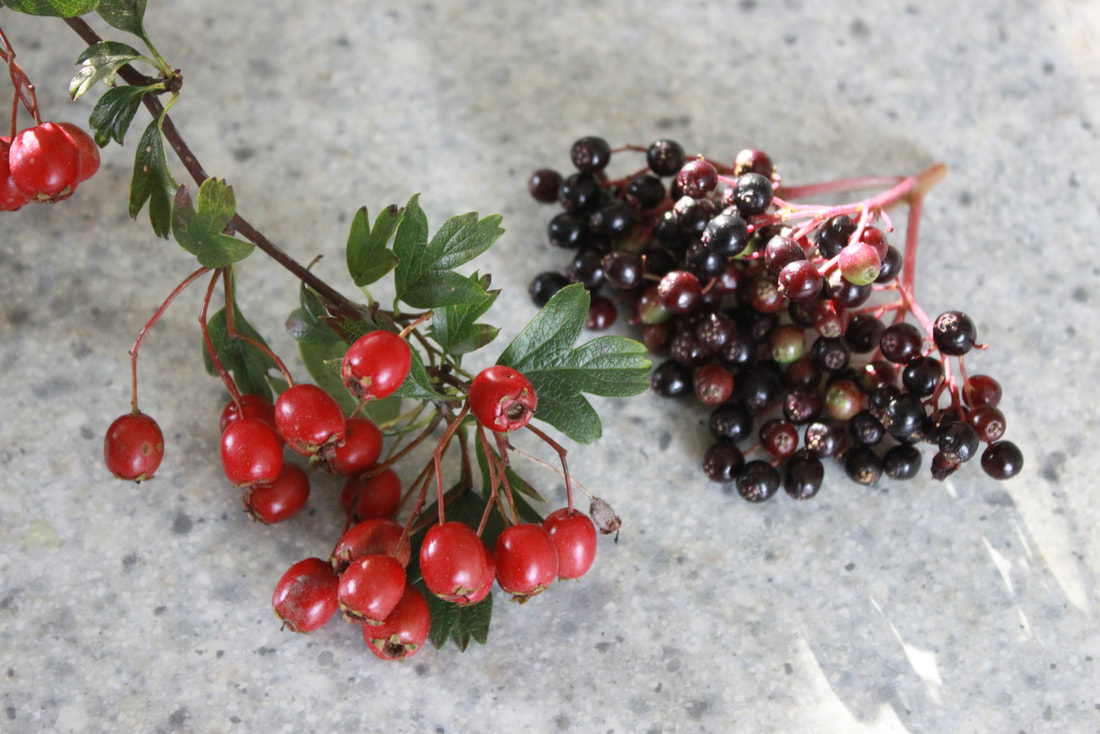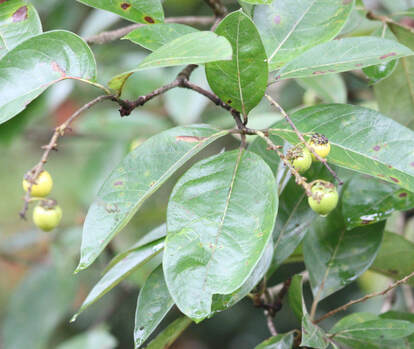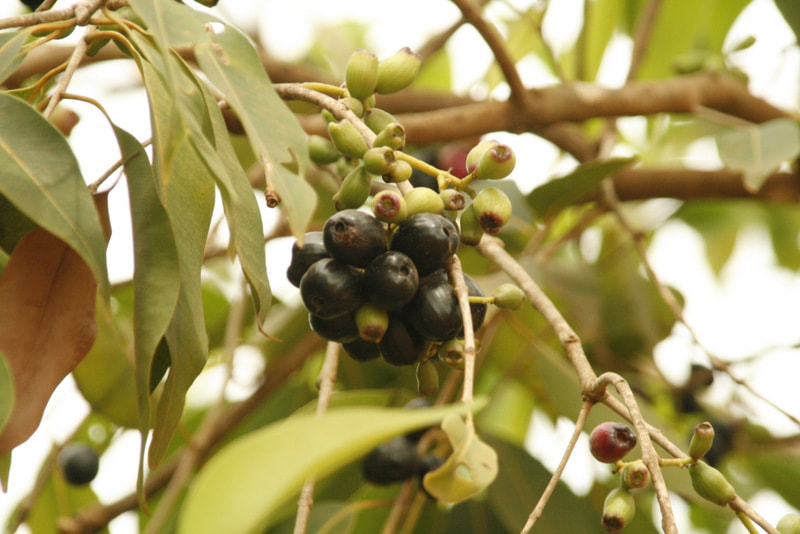BENEFICIAL BERRIES
Beneficial Berries
by Rosemary Low
by Rosemary Low
“Berry: any small juicy or fleshy fruit” is the dictionary definition. We use it loosely to also refer to drupes such as hawthorn berries: drupes have a hard stone in the centre, as do cherries, for example. Berries are consumed eagerly by many species of softbills, parrots and finches. They are under-used items by most bird keepers. In my garden House Sparrows eat the tiny, bright red berries of a shrub whose name I do not know; they also consume the berries of Pyracantha. Watching them made me realise that more bird species eat berries than we might realise.
To us the word berry conjures up popular cultivated fruits such as strawberries, raspberries and blueberries, also redcurrants and blackcurrants. The general health-giving benefits of these fruits for humans has long been known. I would like to emphasise these benefits, for our birds -- and for ourselves.
Recent research indicates more specific advantages. Scientists in Boston, USA, suggest that the risk of heart attacks in women can be reduced by almost a third by consuming just three handfuls of either fruit every week. (Apparently this research has not been carried out on men.) Even those who ate a lot of other fruits and vegetables were more likely to have heart attacks if they avoided strawberries and blueberries.
To us the word berry conjures up popular cultivated fruits such as strawberries, raspberries and blueberries, also redcurrants and blackcurrants. The general health-giving benefits of these fruits for humans has long been known. I would like to emphasise these benefits, for our birds -- and for ourselves.
Recent research indicates more specific advantages. Scientists in Boston, USA, suggest that the risk of heart attacks in women can be reduced by almost a third by consuming just three handfuls of either fruit every week. (Apparently this research has not been carried out on men.) Even those who ate a lot of other fruits and vegetables were more likely to have heart attacks if they avoided strawberries and blueberries.
House Sparrows feeding on cotoneaster berries
Both fruits contain special flavonoid plant compounds called anthocyanins that may help to unblock arteries. Flavonoid compounds protect against disease by extending the action of Vitamin C and acting as antioxidants. Antioxidants are believed to neutralise free radicals and may reduce or even help prevent some of the damage they cause. Free radicals occur naturally in the body, but environmental toxins (including ultraviolet light, radiation, cigarette smoke and air pollution) can also increase their number. Free radicals are believed to contribute to the ageing process as well as the development of a number of health problems, including heart disease. These substances disrupt important metabolic processes in the body which can result in cancer and various physical problems.
Strawberries and blueberries
Parrots, especially older ones, suffer from the same heart conditions as humans. While obviously the benefits of strawberries and blueberries in the diet of many of the birds we keep has not been tested, it would be surprising if the results were different.
I could not persuade my parrots to eat strawberries until I realised that those we buy in small containers are overripe from a parrot’s viewpoint. However, many punnets contain one or two that are not quite ripe. Put one on a stainless steel fruit holder and it is likely to be readily eaten. Note that strawberries have the lowest glycaemic load of any fruit, meaning that they provide sustained energy levels at only a few calories.
I have never forgotten seeing a Hyacinthine Macaw picking off the tiny seeds on the outside of a strawberry with its massive bill! It is remarkable that the largest bill in the parrot family could perform such intricate manoevres!
Strawberries and blueberries
Parrots, especially older ones, suffer from the same heart conditions as humans. While obviously the benefits of strawberries and blueberries in the diet of many of the birds we keep has not been tested, it would be surprising if the results were different.
I could not persuade my parrots to eat strawberries until I realised that those we buy in small containers are overripe from a parrot’s viewpoint. However, many punnets contain one or two that are not quite ripe. Put one on a stainless steel fruit holder and it is likely to be readily eaten. Note that strawberries have the lowest glycaemic load of any fruit, meaning that they provide sustained energy levels at only a few calories.
I have never forgotten seeing a Hyacinthine Macaw picking off the tiny seeds on the outside of a strawberry with its massive bill! It is remarkable that the largest bill in the parrot family could perform such intricate manoevres!
Crimson-bellied Conures on strawberries
The health benefits of blueberries are really extraordinary. They contain minerals that parrots need in small amounts, such as potassium, manganese, copper, iron and zinc. Few fruits have a higher content of antioxidants. Research studies suggest that the chlorogenic acid in these berries helps to lower blood sugar levels and to control blood glucose levels in type-II diabetes. Yes, parrots too can suffer from this condition.
In Canada my friend Wendy Huntbatch runs a parrot sanctuary for about 700 birds. She told me: “They love blueberries - and of course they are available year round now. You can always tell how much they enjoyed them by how many purple droppings need to be cleaned away! Last summer the local berries were very late so people must have lost interest - we had tons delivered here. The birds ate so many you would not believe it. “
Seasonally-available cranberries also have great health benefits but they are acid and bitter, so most of the birds we keep will not eat them.
Raspberries
Many birds will eat raspberries. Parrots and parakeets prefer them before they are fully ripe. I grow my own and find they are one of the easiest and most prolific fruits to grow, fruiting from June until October. They seem to fruit best after a hard winter. The fruit has a wide range of health-giving properties such as antioxidants and vitamins A, B,C, E and K, as well as being high in important minerals such as potassium, manganese, copper, iron and magnesium.
Hawthorn berries
In the UK the berries we are most likely to feed to our birds are those of hawthorn (Crataegus oxycanthus). These berries are especially relished when plump and ripe and many parrots become excited at the sight of them. The fleshy part is discarded and the small hard kernel is manipulated between both mandibles until a cracking sound is heard and the kernel is extracted. Softbills such as thrushes swallow the berries whole. The wild hedgerows often have a glut of hawthorn berries from September to November. They are very important as they enable many birds to put on weight before winter sets in.
This tree has been introduced to Australia. In Canberra, where hawthorn and Pyracantha bushes are very popular as ornamental hedges, the berries of both are eagerly eaten by Gang Gang Cockatoos. In aviaries, even Budgerigars are known to eat the orange-red berries of Pyracantha coccinea.
In Canada my friend Wendy Huntbatch runs a parrot sanctuary for about 700 birds. She told me: “They love blueberries - and of course they are available year round now. You can always tell how much they enjoyed them by how many purple droppings need to be cleaned away! Last summer the local berries were very late so people must have lost interest - we had tons delivered here. The birds ate so many you would not believe it. “
Seasonally-available cranberries also have great health benefits but they are acid and bitter, so most of the birds we keep will not eat them.
Raspberries
Many birds will eat raspberries. Parrots and parakeets prefer them before they are fully ripe. I grow my own and find they are one of the easiest and most prolific fruits to grow, fruiting from June until October. They seem to fruit best after a hard winter. The fruit has a wide range of health-giving properties such as antioxidants and vitamins A, B,C, E and K, as well as being high in important minerals such as potassium, manganese, copper, iron and magnesium.
Hawthorn berries
In the UK the berries we are most likely to feed to our birds are those of hawthorn (Crataegus oxycanthus). These berries are especially relished when plump and ripe and many parrots become excited at the sight of them. The fleshy part is discarded and the small hard kernel is manipulated between both mandibles until a cracking sound is heard and the kernel is extracted. Softbills such as thrushes swallow the berries whole. The wild hedgerows often have a glut of hawthorn berries from September to November. They are very important as they enable many birds to put on weight before winter sets in.
This tree has been introduced to Australia. In Canberra, where hawthorn and Pyracantha bushes are very popular as ornamental hedges, the berries of both are eagerly eaten by Gang Gang Cockatoos. In aviaries, even Budgerigars are known to eat the orange-red berries of Pyracantha coccinea.
Berries of hawthorn and elder
Hawthorn berries have long been known to have properties that make them a safe and effective treatment for the early stage of heart disease and in general for strengthening the heart, and are also useful in treating high blood pressure. Experiments carried out on humans and on animal confirm this. Animal and laboratory studies have found that hawthorn contains active compounds with antioxidant properties that help protect against the formation of plaques.
Birds, especially parrots because the larger species live so long are, like humans, also susceptible to atherosclerosis. This is the condition where plaque builds up in the arteries that supply blood to the brain, possibly resulting in a stroke.
Elderberries
Ripe elderberries are also free for the picking and relished by many of our aviary inhabitants. They are not recommended for birds kept indoors -- unless you like purple walls! Research indicates the quite amazing benefits of the fruits and flowers. Indeed, the juice, which apparently contains bioflavonoids and other proteins which destroy the ability of cold and flu viruses to infect cells, was used to treat an influenza epidemic in Panama in 1951. People with flu who took elderberry juice reported less severe symptoms and felt better much faster than those who did not. Today we rely on vaccination which can have unpleasant side effects: natural remedies are largely forgotten.
In humans elderberry is used for its antioxidant activity, to lower cholesterol, to improve vision, to boost the immune system, to improve heart health and for coughs, colds, flu, bacterial and viral infections and tonsilitis. A remarkable cure-all which probably has highly beneficial properties for our birds.
Elderberries contain tannin but I do not know if the quantities are significant to feed to birds such a toucans and lories which suffer from iron storage disease. It seems to be a better option for these birds than drinking tea!
These valuable berries also contain organic pigments, amino acids, carotenoids, sugar, rutin, vitamins A and B and a large amount of vitamin C. They can be used as a mild laxative. The flavonoids, including quercetin, are believed to be the reason for the therapeutic actions of the elderberry flowers and berries. According to test tube studies these flavonoids include anthocyanins: powerful .
A natural food
We need to stop thinking about parrots as primarily seedeaters and nut-eaters. Desert birds, such as Budgerigars and Cockatiels, are primarily seedeaters but this is not true of the majority of parrots.
Small berries make up a large part of the diet of may parrots in the wild. They might be eating the fleshy part, or they might take only the seeds. In South America I have often watched parrots feeding on berries. In Guyana Painted Conures eat the orange-red, berry-like drupes of kabukalli (Goupia glabra). Each drupe is about 5mm in width and contains five to ten seeds. Scarlet Macaws also feed on these little berries as do White-eyed Conures in Brazil. In Guyana I also watched Brown-throated Conures feeding on small dark berries. On this occasion I tasted them to find they were quite bitter.
When I visited Panama in 2012 I discovered that the small berries of nance (Byrsonymia crassifolia) are eaten by the Azuero Conure (Pyrrhura eisenmanni) and by the Brown-throated Conure (Aratinga pertinax).
Birds, especially parrots because the larger species live so long are, like humans, also susceptible to atherosclerosis. This is the condition where plaque builds up in the arteries that supply blood to the brain, possibly resulting in a stroke.
Elderberries
Ripe elderberries are also free for the picking and relished by many of our aviary inhabitants. They are not recommended for birds kept indoors -- unless you like purple walls! Research indicates the quite amazing benefits of the fruits and flowers. Indeed, the juice, which apparently contains bioflavonoids and other proteins which destroy the ability of cold and flu viruses to infect cells, was used to treat an influenza epidemic in Panama in 1951. People with flu who took elderberry juice reported less severe symptoms and felt better much faster than those who did not. Today we rely on vaccination which can have unpleasant side effects: natural remedies are largely forgotten.
In humans elderberry is used for its antioxidant activity, to lower cholesterol, to improve vision, to boost the immune system, to improve heart health and for coughs, colds, flu, bacterial and viral infections and tonsilitis. A remarkable cure-all which probably has highly beneficial properties for our birds.
Elderberries contain tannin but I do not know if the quantities are significant to feed to birds such a toucans and lories which suffer from iron storage disease. It seems to be a better option for these birds than drinking tea!
These valuable berries also contain organic pigments, amino acids, carotenoids, sugar, rutin, vitamins A and B and a large amount of vitamin C. They can be used as a mild laxative. The flavonoids, including quercetin, are believed to be the reason for the therapeutic actions of the elderberry flowers and berries. According to test tube studies these flavonoids include anthocyanins: powerful .
A natural food
We need to stop thinking about parrots as primarily seedeaters and nut-eaters. Desert birds, such as Budgerigars and Cockatiels, are primarily seedeaters but this is not true of the majority of parrots.
Small berries make up a large part of the diet of may parrots in the wild. They might be eating the fleshy part, or they might take only the seeds. In South America I have often watched parrots feeding on berries. In Guyana Painted Conures eat the orange-red, berry-like drupes of kabukalli (Goupia glabra). Each drupe is about 5mm in width and contains five to ten seeds. Scarlet Macaws also feed on these little berries as do White-eyed Conures in Brazil. In Guyana I also watched Brown-throated Conures feeding on small dark berries. On this occasion I tasted them to find they were quite bitter.
When I visited Panama in 2012 I discovered that the small berries of nance (Byrsonymia crassifolia) are eaten by the Azuero Conure (Pyrrhura eisenmanni) and by the Brown-throated Conure (Aratinga pertinax).
In Argentina I have seen Yellow-collared Macaws (Primolius auricollis) feeding on the small berries of the introduced chinaberry (Melia azerdarach). I once watched a young one, fed by its parents a few moments earlier, reach up for the yellow or green berries and take them without transferring them to its foot. Berries, being soft, must be easier for young birds to consume. Harder nuts require greater skill and dexterity.
In the Brazilian Pantanal I watched the same species of macaw feeding on what looked like tiny plums; they were eating them green.
Throughout South America many parrots feed on the berries of chinaberry, even large macaws such as the Military in Mexico. The chinaberry tree is a native of Asia, where its berries are eaten by Ringneck Parakeets.
So, berries are not just useful in varying the diet of our birds and adding enjoyment in the form of natural foods. Many of those grown commercially have extraordinary health benefits as do some that we can pick free in the hedgerows. We do not know about the hundreds, or probably thousands, of species of berries found in rainforests, but their importance in the diet of toucans, trogons, hornbills and parrots, for example, indicates that they are highly nutritious and very attractive to a host of bird species.
They might have another benefit for aviary birds. It has recently been discovered that a chemical compound in strawberries, raspberries and blueberries shows a striking similarity to valproic acid, used as a mood-enhancing drug in humans. So perhaps these berries can make our birds happy -- as well as healthy!
In the Brazilian Pantanal I watched the same species of macaw feeding on what looked like tiny plums; they were eating them green.
Throughout South America many parrots feed on the berries of chinaberry, even large macaws such as the Military in Mexico. The chinaberry tree is a native of Asia, where its berries are eaten by Ringneck Parakeets.
So, berries are not just useful in varying the diet of our birds and adding enjoyment in the form of natural foods. Many of those grown commercially have extraordinary health benefits as do some that we can pick free in the hedgerows. We do not know about the hundreds, or probably thousands, of species of berries found in rainforests, but their importance in the diet of toucans, trogons, hornbills and parrots, for example, indicates that they are highly nutritious and very attractive to a host of bird species.
They might have another benefit for aviary birds. It has recently been discovered that a chemical compound in strawberries, raspberries and blueberries shows a striking similarity to valproic acid, used as a mood-enhancing drug in humans. So perhaps these berries can make our birds happy -- as well as healthy!
All photographs and text on this website are the copyright of |

